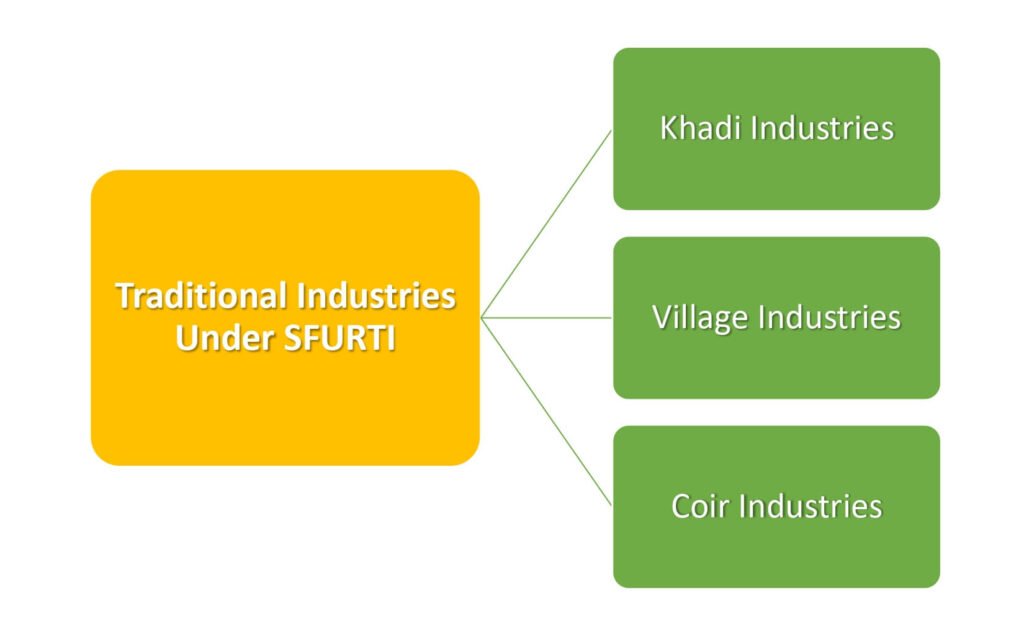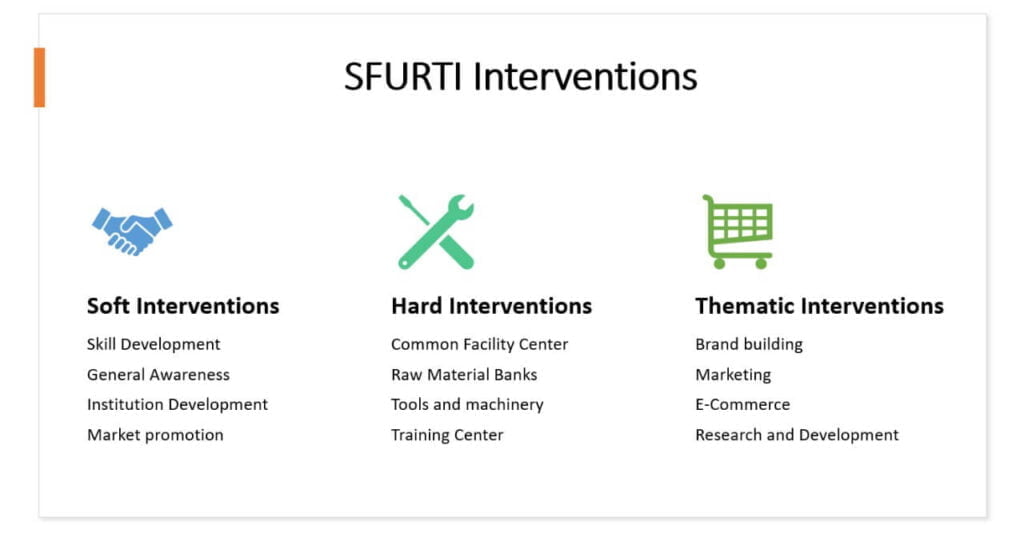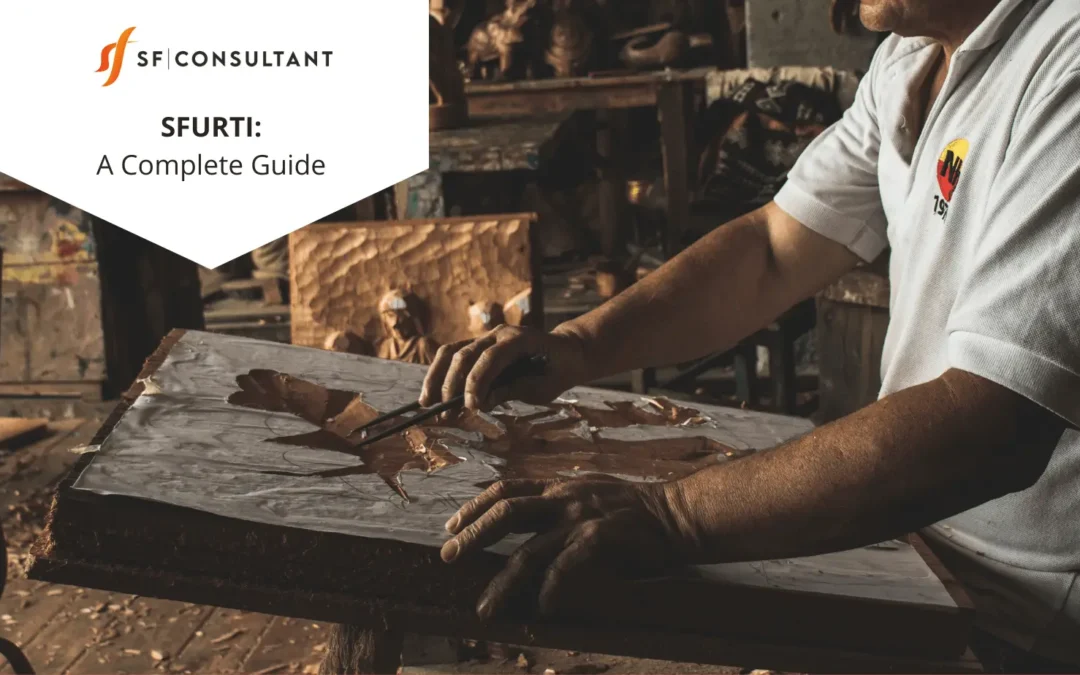The SFURTI scheme provides funds for developing clusters of traditional industry products manufacturing, designing, and marketing.
Under the SFURTI Scheme, the Government, along with the agencies formed under it actively participate in setting up the clusters and their successful functionalization. These clusters constitute local artisans skilled in some traditional art or craft.
The Government grants aid up to Rs.5 Crore in setting up a cluster under the SFURTI scheme.
The SFURTI scheme, first introduced in 2004, has successfully approved 498 clusters all over India. So far, 251 clusters are functional under the SFURTI scheme, and about 3 Lakh artisans are taking advantage of it.
You will understand the summary analysis of the SFURTI Scheme through this article.
Table of contents
Also Read: How the Tradition of Bagh Print is Being Kept Alive?
Objectives of the Scheme
As per the guidelines document of the SFURTI scheme, following are the aims and objectives:
- Organize clusters for traditional industries and artisans by providing support for their long-term sustainability.
- Provide sustained employment for traditional industry artisans and rural entrepreneurs.
- Enhance the marketability of products of the cluster by providing support for new products, design intervention and improved packaging.
- Provide traditional artisans of associated clusters with improved skills and capabilities through training and exposure visits.
- Take provision of common facilities and improved tools and equipment for artisans.
- Strengthen the cluster governance system with the active participation of stakeholders in emerging challenges and opportunities.
- Build up innovative and traditional skills, improved technologies, and advanced processes to gradually replicate similar models of cluster-based regenerated traditional industries.
- Look for the setting up of multi-product clusters.
- Identify and understand a cluster’s target customer.
- Develop product lines of a diversified basket of products understanding the target customer.
- Make a paradigm shift from a supply-driven selling model to a market-driven model.
- Tap e-commerce as a major-marketing channel in outreaching and growing market penetration of E-Commerce.
- To tap into the prospects of the e-retail space.
Who is Eligible to Receive Benefits Under the Scheme?

The scheme assists in building up traditional industrial markets. As per the guidelines of the SFURTI scheme, the following are the kinds of traditional industries, categorized to be eligible for the scheme:
-
- Khadi Industries
- Village Industries and
- Coir Industries
The three categories under the SFURTI scheme have been further classified. Below are the criteria for categorization of the scheme:
Khadi Industries
“Khadi”, is a cloth woven on a handloom using cotton, silk or woolen yarn handspun, a mixture of any two or all such yarns. Therefore, in the khadi industry, manufacturing units for handmade and hand woven, woolen, muslin and silk varieties also come under it.
Also Read: 6 Essential Tips for Brand Building through Social Media
Village Industries
This industry comprises goods or services which are located in a rural area and are manufactured without the use of power and in which per capita fixed capital investment does not exceed Rs. 1 Lakh (except for hilly areas, wherein the limit is Rs. 1.5 lakh).
Coir Industries
The industry is an agro-based traditional industry. A Coir is a bi-product made out of coconuts. A range of products such as mats, rope etc. is made using age-old fibre extraction techniques and spinning mechanics. Mostly, coconut-producing states such as Kerala, Tamil Nadu, Karnataka, Andhra Pradesh, Orissa, West Bengal, Maharashtra, Assam, Tripura, etc. contribute to the Coir Industry.
Some of the major village industries that have been further classified:
- Mineral Based Industry;
(a) Cottage Pottery Industries
(b) Lime Industries - Forest-Based Industry
(a) Medicinal Plants Industries
(b) Bee-keeping
(c) Minor Forest-based Industries - Agro-Based & Food Processing Industry
(a) Pulses & Cereals Processing Industries
(b) Gur & Khandsari Industries
(c) Palmer Industries
(d) Fruit & Vegetable Processing Industries
(e) Village Oil Industries - Polymer & Chemical Based Industry
(a) Cottage Leather Industries
(b) Non-edible & Soap Industries
(c) Cottage match Industries
(d) Plastics Industries - Rural Engineering & Bio-Technology Industry
(a) Non-Conventional Energy
(b) Carpentry & Black Smithy
(c) Electronics - Hand-Made Paper & Fiber Industry;
(a) Handmade Paper Industries
(b) Fiber Industries - Service and Textiles Industry;
(a) Apparel and garments
(b) Embroidery and surface ornamentations
(c) Fabric and yarn dyeing
(d) Services
Project Interventions and Training Under the Scheme

SFURTI provides means of sanctioning training, raw-material or other financial benefits for cluster development. Under these interventions training, equipment, machinery and marketing assistance are provided.
The scheme covers three types of Interventions which are Soft Intervention, Hard Intervention and Thematic Intervention which are further described below:
Also Read: Here is Why Your Company Needs A Blog?
-
Soft Interventions
Under soft intervention, the project consists of activities such as:
- General awareness, counseling, motivation and trust-building.
- Skill development and capacity building for the entire value chain of different skills need to be imparted.
- Institution development.
- Exposure visits.
- Market promotion initiatives.
- Design and product development.
- Participation in seminars, workshops and training programmers on technology up-gradation, etc.
-
Hard Interventions
It includes the creation of the following facilities:
- Multiple facilities for multiple products and packaging wherever needed.
- Common facility centers (CFCs);
- Raw material banks (RMBs);
- Up-gradation of production infrastructure;
- Tool and technological up-gradation such as charkha up-gradation, tool-kit distribution etc.
- Warehousing facility.
- Training center;
- Value addition and processing center/ multi-products
-
Thematic Interventions
Under Thematic Intervention, which is an addition to the support provided in the Hard and Soft interventions. It provides interventions at a sectoral level where several clusters in the same cluster category can collaborate in featuring themselves in domestic and international markets.
Therefore, Thematic Intervention includes the following roles:
- Brand building and promotion campaign;
- New media marketing;
- E-Commerce initiatives;
- Innovation;
- Research & development initiatives; and
- Developing institutional linkages with the existing & proposed clusters
Also Read: Everything you need to know about Institution Building in SFURTI
The Process of Cluster Development Under SFURTI Scheme
The process of implementing the SFURTI Scheme rests upon the work and profile of the agencies.
The process involves the following list of bodies & agencies:
- Scheme Steering Committee
- Nodal Agencies
- Technical Agencies
- Implementing Agencies
- Special Purpose Vehicle
- Working Committee
Let us understand in short detail the functions performed in the process of cluster development:
A. Scheme Steering Committee (SSC):
An SSC is constituted in providing the overall policy, coordination and management of the Scheme with the Ministry of MSME. The SSC will compromise with the following list of members:
| 1 | Secretary, Ministry of MSME | Chairman |
| 2 | Additional Secretary and Development Commissioner | Member |
| 3 | Additional Secretary and Financial Adviser (AS & FA), Ministries of MSME (or a representative) | Member |
| 4 | Principal Adviser, PAMD, Niti Aayog | Member |
| 5 | Chief Executive Officer, KVIC | Member |
| 6 | Secretary, Coir Board | Member |
| 7 | Representative of Indian Banks Association (IBA) | Member |
| 8 | Representative of National Bank for Agriculture and Rural Development (NABARD) | Member |
| 9 | 5 Cluster Experts- to be nominated by Ministry of MSME | Member |
| 10 | DC (Handlooms) | Member |
| 11 | DC (Handicrafts) | Member |
| 12 | Joint Secretary (NRLM), M/o Rural Development | Member |
| 13 | Joint Secretary, M/o Food Processing Industry | Member |
| 14 | JS, Ministry of MSME | Member Convenor |
Also Read: Why Madhubani Art is Back on Trend- An Explanation
B. Nodal Agency
The Nodal Agencies are national-level institutions with sectoral expertise in a major sub-sector of traditional industry and are operating in the field of cluster development for at least five years.
NA is appointed by the SSC and selected on their competency in cluster development, project management and facilitation of access to the market for traditional industry.
Such NA’s will be assigned clusters which were not assigned to KVIC or Coir Board or others.
The scheme enlists 34 institutions as Nodal Agencies. As a technical agency, SF Consultant have supported multiple Nodal Agencies. It includes Council for Handicrafts Development Corporation (COHANDS), Foundation for MSME Cluster (FMC), Khadi & Village Industries Commission (KVIC) etc.
We further explained the Roles and Responsibilities of a Nodal Agency under SFURTI Scheme in a separate article, so do check that out.
C. Technical Agency
Technical agencies are established national-level institutions. They have proven expertise in artisanal and small enterprise cluster development.
The task of a technical agency is to provide technical support to NAs and IAs via ‘handholding’ to establish an SFURTI cluster.
The primary duty of the TA is to prepare DPRs and validate Cluster Action Plans, conducting training with Cluster Development Executives (CDEs) and other officials of IAs.
You can read all the functions and qualifications for an TA in a separate article.
D. Implementing Agency
The Implementing Agencies are non-government organizations (NGOs) or institutions of Central and State Government and semi-Government institutions, field functionaries of State and Central Government, Panchayati Raj institutes etc., having expertise in cluster development.
Private sector participation is also allowed for implementing a cluster project. Such as the Corporate or Corporate Social Responsibility (CSR) foundation with expertise in cluster development are encouraged to participate as IA.
For a cluster, one IA is assigned for its development. However, if an IA has state-wide coverage, it can set up more clusters after assessment by NAs.
An IA is selected after reviewing its regional reputation and experience at the grass-root level and is then appointed by a Nodal Agency (NA).
It is specifically appointed to look after the implementation of the cluster development program and to take necessary steps for its further development as per the scheme.
A Cluster Development Executive (CDE) is appointed on a full-time executive role by an IA who supports the implementation of the project as per the approved DPR.
To learn more about the Roles and Responsibilities of an IA, we have written a separate article for the same.
Also Read: 6 Big Ways Social Media Has Impacted the PR Process
E. Special Purpose Vehicle (SPV)
An IA establishes an SPV, and without it, a cluster cannot be approved. After the project implementation period is over, SPV is used to sustain a cluster.
An SPV will be formed for each cluster which will be registered under the following laws:
- A Society under Societies (Registration) Act, 1860;
- A Co-operative Society under an appropriate statute;
- A Producer Company under Section 465(1) of Companies Act, 2013 (18 of 2013);
- Under Section 8 of the Companies Act, 2013 (18 of 2013)
- A Trust;
- Any other legal entity, with the prior approval of SSC.
An SPV formed for each cluster should have a minimum 33% representation of artisans in the Governing body/ Managing Committee.
In case a Panchayati Raj Institute develops a cluster and becomes an IA, it can form an SPV ensuring the governing body of the SPV should have a 33% holding to micro-enterprise or beneficiaries of the cluster.
If SPV is promoted for a cluster by a private entity, then the shareholding of lead investors or private partners shall not exceed 50% of the total equity.
F. Working Committee
The scheme further envisions the sustainability of a cluster by forming a Working Committee to look after CFC, including facilities and infrastructure created by the SFURTI grants.
The working committee will look after sustainability by improving production and marketing to the advantage of the artisans. The working committee will have the following members:
- A Chief Functionary of the IA-Convener.
- Representative of a Nationalized bank operating in the area;
- 3-artisans nominated by the IA (including at least one woman) on an annual rotation basis, re-nomination may not be allowed in five years;
- Representative of the NA; and
- GM, DIC or his representatives.
The working committee will meet at least once a month to review the operational and maintenance aspects of the CFC.
How Financial Assistance Provided Under the Scheme?
Financial assistance to a maximum of Rs.5 Crores is available under the SFURTI scheme for any cluster development project.
NAs are responsible for making payments after receiving financial assistance from the Ministry of MSME for any cluster.
The financial assistance under the scheme has been classified according to the following criteria mentioned in the table below:
| Type of clusters | Per Cluster Budget Limit |
| Regular Clusters (upto 500 artisans) | Rs. 2.50 Crore |
| Major Cluster (more than 500 aritsans) | Rs. 5.00 Crore |
The funding is provided as per the cost of the project by the Ministry.
The cost of the project is based on the cost incurred in the hard intervention and soft intervention. It also includes the cost of professional services by the TA, the cost incurred by the IA for engaging a CDE and other administrative expenses incurred by the IA.
The ministry transfers the funds to an NA under two heads which are:
- SFURTI Programme Fund
- SFURTI Administrative Fund
The scheme has an efficient and robust method for making financial assistance which you can read in “How the Scheme Funds SFURTI Clusters?”.
Also Read: How to Apply and Receive Assistance Under SFURTI Scheme?
How does a SFURTI Cluster Become Self-Reliant?
The Government targets to cover more than 1000 clusters across the country during the scheme implementation, wherein approx. 6,00,000 artisans/beneficiaries are proposed to be covered under the scheme through the cluster project interventions.
The scheme envisions the timeframe for the implementation of the project at the most 12-18 months.
The government for further sustainability of a cluster provides a convergence provision and structure synergies between different private initiatives and the government for long-term planning and implementation of funds in a cluster.
The scheme allows private participation by becoming an Implementing Agency or Technical Agency. The scheme allows private partners to contribute at least 50% of the project cost excluding the cost of land for the cluster development.
The scheme also allows additional financial and management support by CSR (Corporate Social Responsibility) foundations that can manage MSME cluster projects and participate either as IA or TA.
Financial institutions are also allowed to fund clusters by participating in an SPVs for a shareholding which shall not exceed 50% of the total equity.
Conclusion
The SFURTI scheme aims to uplift the traditional industry and make its products available in mainstream competitive markets.
In the same league, the scheme makes provisions for establishing clusters of artisans. Therefore, it has attracted public organizations and private entities to cluster development projects.
Clusters under the SFURTI scheme are developed by a comprehensive business plan with a future sustainability model and become self-reliant in attracting funds and generating returns for the artisans working in a cluster. Therefore, the SFURTI scheme develops a robust model of rural entrepreneurship.
We at SF Consultant assist in the development of the clusters by guiding NAs and IAs with our technical skills. Our team of professionals helps them in developing business plans, providing technical support and guidance in the proper development and execution of a DPR for cluster development.
Submit us your queries by contacting us.

